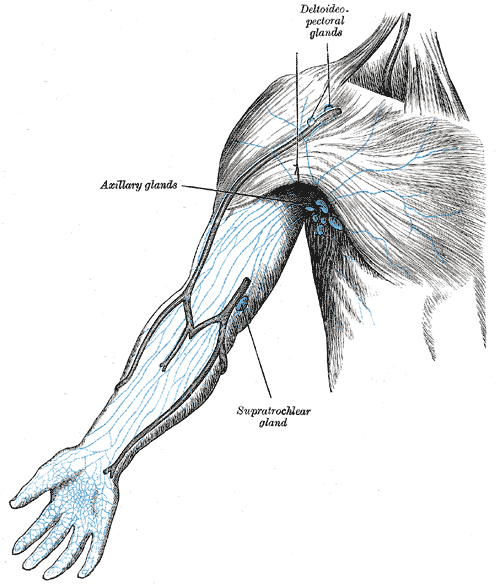[4]
Jatoi I, Hilsenbeck SG, Clark GM, Osborne CK. Significance of axillary lymph node metastasis in primary breast cancer. Journal of clinical oncology : official journal of the American Society of Clinical Oncology. 1999 Aug:17(8):2334-40
[PubMed PMID: 10561295]
[5]
Mohseni S, Shojaiefard A, Khorgami Z, Alinejad S, Ghorbani A, Ghafouri A. Peripheral lymphadenopathy: approach and diagnostic tools. Iranian journal of medical sciences. 2014 Mar:39(2 Suppl):158-70
[PubMed PMID: 24753638]
[7]
Willard-Mack CL. Normal structure, function, and histology of lymph nodes. Toxicologic pathology. 2006:34(5):409-24
[PubMed PMID: 17067937]
[8]
Dialani V, James DF, Slanetz PJ. A practical approach to imaging the axilla. Insights into imaging. 2015 Apr:6(2):217-29. doi: 10.1007/s13244-014-0367-8. Epub 2014 Dec 23
[PubMed PMID: 25534139]
[9]
Bautch VL, Caron KM. Blood and lymphatic vessel formation. Cold Spring Harbor perspectives in biology. 2015 Mar 2:7(3):a008268. doi: 10.1101/cshperspect.a008268. Epub 2015 Mar 2
[PubMed PMID: 25731762]
Level 3 (low-level) evidence
[10]
Butler MG, Isogai S, Weinstein BM. Lymphatic development. Birth defects research. Part C, Embryo today : reviews. 2009 Sep:87(3):222-31. doi: 10.1002/bdrc.20155. Epub
[PubMed PMID: 19750516]
[12]
Maiborodin IV, Kozyakov AE, Babayants EV, Krasil'nikov SE. Features of Blood Supply to Axillary Lymph Nodes in Breast Cancer Patients. Bulletin of experimental biology and medicine. 2017 May:163(1):82-86. doi: 10.1007/s10517-017-3743-9. Epub 2017 Jun 3
[PubMed PMID: 28580489]
[13]
Hodler J, Kubik-Huch RA, von Schulthess GK, Gasparotti R, Shah L. Brachial and Lumbosacral Plexus and Peripheral Nerves. Diseases of the Brain, Head and Neck, Spine 2020–2023: Diagnostic Imaging. 2020:():
[PubMed PMID: 32119244]
[15]
Lucci A, McCall LM, Beitsch PD, Whitworth PW, Reintgen DS, Blumencranz PW, Leitch AM, Saha S, Hunt KK, Giuliano AE, American College of Surgeons Oncology Group. Surgical complications associated with sentinel lymph node dissection (SLND) plus axillary lymph node dissection compared with SLND alone in the American College of Surgeons Oncology Group Trial Z0011. Journal of clinical oncology : official journal of the American Society of Clinical Oncology. 2007 Aug 20:25(24):3657-63
[PubMed PMID: 17485711]
[16]
Belmonte R, Monleon S, Bofill N, Alvarado ML, Espadaler J, Royo I. Long thoracic nerve injury in breast cancer patients treated with axillary lymph node dissection. Supportive care in cancer : official journal of the Multinational Association of Supportive Care in Cancer. 2015 Jan:23(1):169-75. doi: 10.1007/s00520-014-2338-5. Epub 2014 Jul 18
[PubMed PMID: 25035064]
[17]
Peters AM, Fowler JC, Britton TB, Solanki CK, Ballinger JR, Ravichandran D, Mortimer PS, Purushotham AD. Functional variation in lymph node arrangements within the axilla. Lymphatic research and biology. 2009:7(3):139-44. doi: 10.1089/lrb.2008.1021. Epub
[PubMed PMID: 19778201]
[18]
Soares EW. Anatomical variations of the axilla. SpringerPlus. 2014:3():306. doi: 10.1186/2193-1801-3-306. Epub 2014 Jun 24
[PubMed PMID: 25045608]
[19]
Nieweg OE, Tanis PJ, Kroon BB. The definition of a sentinel node. Annals of surgical oncology. 2001 Jul:8(6):538-41
[PubMed PMID: 11456054]
[21]
Brar P, Jain S, Singh I. Complications of Axillary Lymph Node Dissection in Treatment of Early Breast Cancer: A Comparison of MRM and BCS. Indian journal of surgical oncology. 2011 Jun:2(2):126-32. doi: 10.1007/s13193-011-0078-2. Epub 2011 Jul 22
[PubMed PMID: 22693405]
[23]
Yen TWF, Laud PW, Pezzin LE, McGinley EL, Wozniak E, Sparapani R, Nattinger AB. Prevalence and Consequences of Axillary Lymph Node Dissection in the Era of Sentinel Lymph Node Biopsy for Breast Cancer. Medical care. 2018 Jan:56(1):78-84. doi: 10.1097/MLR.0000000000000832. Epub
[PubMed PMID: 29087982]
[24]
Giuliano AE, Ballman K, McCall L, Beitsch P, Whitworth PW, Blumencranz P, Leitch AM, Saha S, Morrow M, Hunt KK. Locoregional Recurrence After Sentinel Lymph Node Dissection With or Without Axillary Dissection in Patients With Sentinel Lymph Node Metastases: Long-term Follow-up From the American College of Surgeons Oncology Group (Alliance) ACOSOG Z0011 Randomized Trial. Annals of surgery. 2016 Sep:264(3):413-20. doi: 10.1097/SLA.0000000000001863. Epub
[PubMed PMID: 27513155]
Level 1 (high-level) evidence
[25]
Warren LE, Miller CL, Horick N, Skolny MN, Jammallo LS, Sadek BT, Shenouda MN, O'Toole JA, MacDonald SM, Specht MC, Taghian AG. The impact of radiation therapy on the risk of lymphedema after treatment for breast cancer: a prospective cohort study. International journal of radiation oncology, biology, physics. 2014 Mar 1:88(3):565-71. doi: 10.1016/j.ijrobp.2013.11.232. Epub 2014 Jan 7
[PubMed PMID: 24411624]
[26]
Lourens GB, Ferrell DK. Lymphatic Filariasis. The Nursing clinics of North America. 2019 Jun:54(2):181-192. doi: 10.1016/j.cnur.2019.02.007. Epub 2019 Mar 27
[PubMed PMID: 31027660]
[27]
Shenoy RK. Clinical and pathological aspects of filarial lymphedema and its management. The Korean journal of parasitology. 2008 Sep:46(3):119-25. doi: 10.3347/kjp.2008.46.3.119. Epub
[PubMed PMID: 18830049]
[28]
Rivadeneira DE, Simmons RM, Christos PJ, Hanna K, Daly JM, Osborne MP. Predictive factors associated with axillary lymph node metastases in T1a and T1b breast carcinomas: analysis in more than 900 patients. Journal of the American College of Surgeons. 2000 Jul:191(1):1-6; discussion 6-8
[PubMed PMID: 10898177]
[29]
Maxwell F, de Margerie Mellon C, Bricout M, Cauderlier E, Chapelier M, Albiter M, Bourrier P, Espié M, de Kerviler E, de Bazelaire C. Diagnostic strategy for the assessment of axillary lymph node status in breast cancer. Diagnostic and interventional imaging. 2015 Oct:96(10):1089-101. doi: 10.1016/j.diii.2015.07.007. Epub 2015 Sep 12
[PubMed PMID: 26372221]
[31]
Akram M, Iqbal M, Daniyal M, Khan AU. Awareness and current knowledge of breast cancer. Biological research. 2017 Oct 2:50(1):33. doi: 10.1186/s40659-017-0140-9. Epub 2017 Oct 2
[PubMed PMID: 28969709]


